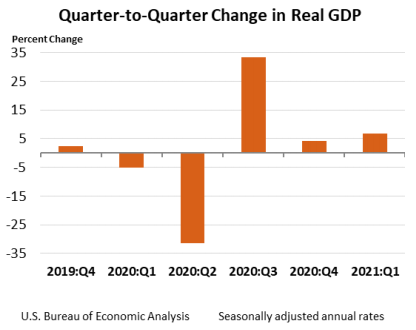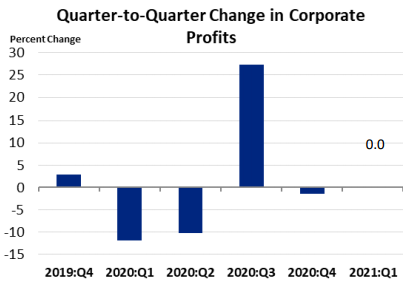Real gross domestic product (GDP) increased at an annual rate of 6.4 percent in the first quarter of 2021, reflecting the continued economic recovery, reopening of establishments, and continued government response related to the COVID-19pandemic. The increase was the same rate as the “advance” estimate released in April. In the first quarter, government assistance payments, such as direct economic impact payments, expanded unemployment benefits, and Paycheck Protection Program loans were distributed to households and businesses through the Coronavirus Response and Relief Supplemental Appropriations Act and the American Rescue Plan Act. In the fourth quarter of 2020, real GDP increased 4.3 percent. For more details, including source data, see the Technical Note and Federal Recovery Programs and BEA Statistics.
GDP highlights
The first-quarter increase in real GDP reflected increases in consumer spending, business investment, government spending, and housing investment that were partially offset by decreases in inventory investment and exports. Imports, a subtraction in the calculation of GDP, increased
- The increase in consumer spending reflected increases in goods (led by motor vehicles and parts) and services (led by food services and accommodations).
- The increase in business investment reflected increases in intellectual property products (led by software) and equipment (led by information processing equipment).
- The increase in government spending primarily reflected an increase in federal spending related to payments made to banks for processing and administering the Paycheck Protection Program loan applications as well as purchases of COVID-19 vaccines for distribution to the public.
- The decrease in inventory investment primarily reflected a decrease in retail trade inventories.
Updates to GDP
The update to GDP reflected upward revisions to consumer spending, business investment, and housing investment that were offset by downward revisions to exports, inventory investment, and state and local government spending.
Personal income and saving
Real disposable personal income (DPI)— personal income adjusted for taxes and inflation—increased 61.7 percent in the first quarter, an upward revision of 0.4 percentage point from the advance estimate.
The increase in current-dollar DPI primarily reflected an increase in government social benefits related to pandemic relief programs, notably direct economic impact payments to households established by the Coronavirus Response and Relief Supplemental Appropriations Act and the American Rescue Plan Act. Personal saving as a percent of DPI was 21.4 percent in the first quarter, an upward revision of 0.4 percentage point.
Corporate profits from current production
Profits decreased less than 0.1 percent in the first quarter after decreasing 1.4 percent at a quarterly rate in the fourth quarter. Corporate profits increased 12.7 percent i the first quarter from one year ago. Profits were impacted by provisions from the Paycheck Protection Program.
- Profits of domestic nonfinancial corporations increased 0.9 percent after decreasing 3.4 percent.
- Profits of domestic financial corporations decreased 0.7 percent after increasing 3.7 percent.
- Profits from the rest of the world decreased 2.1 percent after decreasing 0.2 percent.
Prices
Prices of goods and services purchased by U.S. residents increased 3.9 percent in the first quarter after increasing 1.7 percent in the fourth quarter. Energy prices increased 46.1 percent in the first quarter while food prices decreased 0.1 percent. Excluding food and energy, prices increased 3.3 percent in the first quarter after increasing 1.6 percent in the fourth quarter.
For more information, read the full report.


